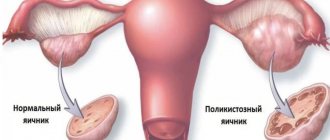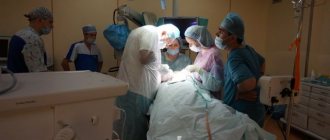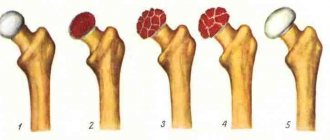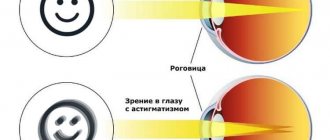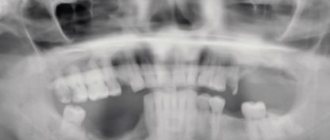AMD is one of the common causes of irreversible vision loss among people over 50 years of age. Since people in this age group make up the majority of the population, vision loss due to macular degeneration poses a challenge to ophthalmologists.
According to WHO, the elderly population in developed countries accounts for approximately 20 percent, and by 2050 these figures are expected to increase to 33 percent. With increasing life expectancy, a steady increase in atherosclerosis and associated pathologies, the problem of AMD seems to be the most pressing.
The reason for decreased vision in AMD is degeneration of the macula, the area of the retina that is responsible for the acuity and sharpness of central vision; peripheral vision does not suffer. Central vision is necessary for a person to read, work and drive a car, therefore the social significance of this disease is explained by the loss of general performance of people who are not yet old. At the same time, the severity of the process accompanying the loss of central vision is closely related to the form of macular degeneration.
Treatment price
At the Moscow Eye Clinic you can undergo a full diagnostic examination and receive recommendations on the most effective treatment methods. A comprehensive examination of the patient (visual acuity test, biomicroscopy, autorefractometry, small-pupil ophthalmoscopy, pneumotonometry) costs 3,500 rubles.
You can find out prices for procedures by calling 8 (800) 777-38-81 or online using the form on the website.
Go to the “Prices” section>>>
Make an appointment
Benefits of treatment at the Santa Clinic
You can undergo examination and treatment of age-related macular degeneration at the Santa Clinic in Chelyabinsk. We employ qualified specialists who have already performed hundreds of complex operations and regularly improve their professional level.
Each patient with age-related macular degeneration receives an individual approach. The doctor listens carefully to complaints and asks about the characteristics of the body. The diagnosis of age-related macular degeneration is made after a detailed examination. If necessary, the ophthalmologist refers the patient to other specialists. The choice of treatment method is carried out in agreement with the patient after receiving the analysis results.
With the experience and qualifications of our ophthalmologists, you can regain your vision from age-related macular degeneration and the ability to see the world clearly and brightly. Make an appointment by phone: the operators will select a time that is convenient for you for your visit.
Forms of AMD
Intense metabolic processes in the retina of the eye lead to the formation of reactive oxygen species, including free radicals, which contribute to the development of degenerative phenomena in tissues in case of insufficient functioning of the antioxidant system (AOS). This leads to the formation in the macular and paramacular areas of the retina of non-cleavable polymer structures - drusen, the basis of which is lipofuscin.
When drusen are deposited, atrophy occurs in the adjacent layers of the retina, and the growth of newly formed pathological vessels in its pigment epithelium is also noted. Then there are scarring processes, which are accompanied by the loss of retinal photoreceptors.
In ophthalmology, it is customary to distinguish between two forms of AMD – dry (non-exudative, atrophic) and wet (exudative, neovascular).
The dry form of AMD is much more widespread than the wet form and is found in 85% of cases. With it, yellowish spots - drusen - are revealed in the macular area. The gradual loss of central vision significantly limits the ability of patients to recognize small details, however, this form of the disease is not as severe as the wet form. The dry form of AMD can gradually progress over several years to the stage of late geographic atrophy (GA), with slow degradation of retinal cells and lead to vision loss.
There is no radical treatment for dry AMD, although some drugs are already in clinical trials. Scientific research shows that certain nutrients, such as vitamins A, C and E, can, if not prevent, then significantly slow down the progression of the disease. Regular intake of certain nutritional supplements - eye vitamins - reduces the risk of developing AMD by almost 25%. Protecting your eyes from UV rays with sunglasses will help reduce the risk of developing AMD or slow its progression in the dry form of the disease.
The wet form of AMD is diagnosed in approximately 15% of cases of age-related macular degeneration. The disease progresses rapidly, leading to significant loss of central vision. In the wet form of macular degeneration, rapid neovascularization occurs with the growth of new blood vessels. These vessels are defective and have fragile walls that allow blood cells and lymph to pass through, which flow out and accumulate under the retina. This condition causes damage to the photoreceptors in the retina, which die, forming blind spots (scotomas) in central vision.
The process of growth of newly formed vessels in wet AMD is called choroidal neovascularization (CNV). Moreover, abnormal vascular growth is a mistake by the body in an attempt to create a new network of blood vessels to provide nutrients and oxygen to the retina. Instead, scars form in place of the ruptured vessels, leading to loss of central vision.
Causes of AMD development
The causes of the disease still remain unclear. But scientists suggest that the following factors may lead to its development:
- Age is the main reason. The incidence increases rapidly with age. Signs of AMD occur in 2% of middle-aged people, in 20% of elderly people aged 65-75 years, and in every third person after 75-80 years.
- Genetic predisposition to the development of the disease, but there are factors that contribute to either the occurrence of the disease or its prevention.
- Race - the prevalence of macular degeneration is more common among Caucasians.
- Heredity (family predisposition) is one of the risk factors in almost 20% of patients with age-related macular degeneration. The risk of AMD increases threefold when the disease occurs in close relatives.
- Cardiovascular disease is one of the main risks for the development of AMD. With atherosclerosis, the risk of the disease increases three times, and with hypertension – seven times.
- Cigarette smoking is the only risk factor confirmed in all studies. Quitting this habit reduces the risk of developing the disease.
- Impact of UV rays on the retina of the eye.
- Poor diet - The risk of AMD is significantly higher in people who eat a lot of saturated fat and have increased body weight.
- Light iris. People with light irises (blue, gray, green eyes) suffer from AMD more often.
- Cataract, especially nuclear. Cataract surgery often contributes to the progression of the disease in people with existing changes in the macula.
Mechanism of development of macular degeneration
The exact pathogenesis of the disease has not yet been identified, but there are many different hypotheses.
Doctors believe that the most common mechanism for the development of macular degeneration is oxidative or oxidative stress to the retina of the eyeball.
Oxidative stress is a special condition of the human body in which an increased amount of free radicals is formed, which, in turn, damage or completely destroy cells, replacing them with scar tissue.
Symptoms of AMD
Age-related macular degeneration is a disease that develops slowly and painlessly, with gradual loss of vision. In rare cases, the onset of vision loss occurs suddenly.
Early signs of gradual vision loss in AMD:
The appearance of dark spots in the central vision. Blurry images. Distortion of the boundaries of objects. Deterioration of color perception. Weakened vision in the dark and in low light.
A simple way to determine AMD is the Amsler test. The lattice or Amsler grid depicts intersecting straight lines with a black dot in the central part. In the presence of AMD, the lines of the pattern may appear blurred or wavy, and some of the grille fragments may appear as darkened, opaque spots.
After conducting the test, an ophthalmologist is able to identify manifestations of the disease long before the development of serious changes in the patient’s vision and recommend additional examination.
How does a person with macular retinal degeneration see?
Macular degeneration
Normal vision
IMPORTANT! When visual acuity decreases both at distance and at close range; difficulties encountered when reading and writing; the need for stronger lighting; If a translucent fixed spot appears before the eye, as well as distortion of the contours of objects, their color and contrast, you should immediately consult an ophthalmologist. The diagnosis of macular degeneration can only be made by a medical specialist. However, self-monitoring of the visual functions of each eye separately using the Amsler test .
Diagnosis of AMD
To diagnose age-related macular degeneration, an accurate history, assessment of visual functions and examination of the patient’s retina using various methods are sufficient. Fluorescein angiography of the ocular fundus (FAGD) is considered one of the informative methods for detecting pathology. FAGD involves the use of contrast agents - fluorescein or indocyanine green, which are injected into the patient's vein, then a series of photographs of the fundus is taken.
The obtained stereoscopic images can be used in the same way as the original ones during dynamic monitoring of a patient with severe dry form of AMD or to evaluate the results of treatment.
Optical coherence tomography (OCT) is used to accurately assess changes in the macula, which makes it possible to detect structural changes even in the early stages of retinal dystrophy.
Table of contents:
Symptoms of age-related macular degeneration Eye macular degeneration: treatment methods Contraindications Advantages of treatment at the Santa Clinic Age-related macular degeneration is one of the common diseases in patients over 50 years of age. The pathology is based on a malnutrition of the retina, in particular its central zone. One of the reasons for such changes is aging, but heredity also plays a significant role. To treat age-related macular degeneration, both traditional and surgical methods are used.
Treatment of different forms of AMD
Despite advances in improving diagnostic techniques for AMD, its treatment remains a challenge. In dry forms of AMD or a high risk of its development, in order to normalize metabolic processes in the retina, it is recommended to carry out a course of antioxidant therapy.
According to scientific research, the beneficial effect of taking antioxidants was noted in participants with intermediate or late stage AMD. Combination therapy with antioxidants, copper and zinc for 5 years reduces the incidence of advanced AMD by 25% and by 19%, and the risk of a decrease in visual acuity by three or more lines.
The use of replacement therapy for the treatment of the dry form of age-related macular degeneration is carried out constantly. It should be used in persons over 50 years of age or at any age in the presence of risk factors (overweight, hypertension, smoking, cataract extraction, family history).
Therapy for wet AMD is aimed at suppressing the growth of newly formed abnormal vessels. There are a number of techniques and medications registered in Russia that stop and reduce the manifestations of neovascularization, which can improve the vision of patients with wet AMD.
Author:
Fomenko Natalia Ivanovna 5/5 (1 rating)
Honey. portal:
Modern methods of treating age-related macular degeneration
Unfortunately, modern world medicine cannot yet offer an effective method that allows you to completely cure age-related macular degeneration of the retina and restore 100% vision. This is why early diagnosis and control of AMD is so important.
For the treatment of patients with age-related macular degeneration the following are used:
- Diet;
- Drug treatment (vitamins, minerals, antioxidants, peptide bioregulators, drugs to lower cholesterol and prevent blood “thickening”);
- Laser therapy (laser coagulation, photodynamic therapy or transpupillary therapy);
- Surgical treatment (intravitreal administration of angiogenesis inhibitors, removal of newly formed membranes or macular translocation).
All existing eye drops can only work on the surface of the eye and are not able to reach the retina, and therefore are not medications for the treatment of AMD.
Only a specialist doctor can select the most effective treatment for retinal dystrophy for you, having determined the form and stage of the disease, taking into account individual contraindications and possible concomitant diseases (such as diabetes, atherosclerosis or hypertension). Self-medication for AMD is strictly contraindicated!
Diet for AMD
Diet is an important and mandatory aspect for the prevention of the early stages of age-related macular degeneration of the retina.
- It is necessary to exclude foods with high cholesterol content from the diet.
- Fill your daily diet with vitamins, microelements and antioxidants.
- The retina needs carotenoids - lutein and zeaxanthin, which are found in egg yolks, spinach, broccoli, bell peppers, pumpkin, tomatoes, carrots, beans, cabbage, grapefruit, kiwi, etc.
- Antioxidants for the eyes contain blueberries, red currants, and red grape seeds.
- Vitamin A (retinol) is part of the visual pigment; it is found in eggs, milk, and the liver of sea fish.
- B vitamins support the nervous and immune systems, healthy growth and reproduction of cells in the body. Their sources are yeast, cottage cheese, cheese, milk, sprouted grains, and legumes.
- Vitamin C has a general strengthening effect on the body as a whole and is important for the prevention of AMD. White cabbage, kiwi, red currants, citrus fruits, green peas, spinach, etc. are rich in it.
- Vitamin E enhances the effect of antioxidants and improves blood circulation in the eye area. Its sources are vegetable oils, nuts, spinach.
- The diet for the prevention and treatment of AMD recommends a varied and balanced diet. You need to eat often and in small portions - 5-6 times a day.
Treatment of age-related macular degeneration at the Eye Clinic of Dr. Belikova.
Our ophthalmology center uses all modern techniques to stop the development of the disease and alleviate the condition of Patients.
Complex therapy for AMD
Complex drug therapy for age-related macular degeneration of the retina includes the Patient sequentially taking a tablet drug at home, and administering the drug topically, “under the eye,” as well as in the form of intramuscular/intravenous injections.
Drug therapy is combined with physiotherapeutic treatment (magnetic or laser therapy).
The period and duration of treatment is determined by the attending physician individually depending on the clinical picture of the disease. Courses of treatment can be prescribed every 4-8 months.
Treatment of the “wet” form of age-related macular degeneration
In the “wet” form of retinal dystrophy, the disease develops rapidly and requires completely different therapy. In this case, our clinic uses the following methods:
- Intravitreal (into the eye cavity) administration of steroids;
- Photodynamic therapy (PDT);
- Laser treatment (laser coagulation and transpupillary thermotherapy - thermal irradiation of the retina with a laser through the pupil);
- A combination of the above methods.

